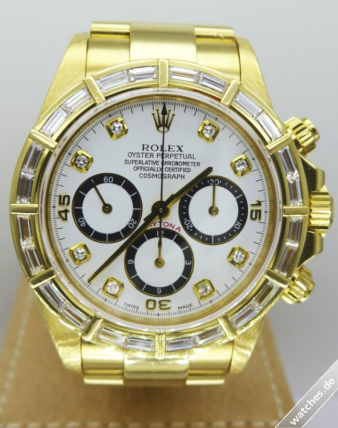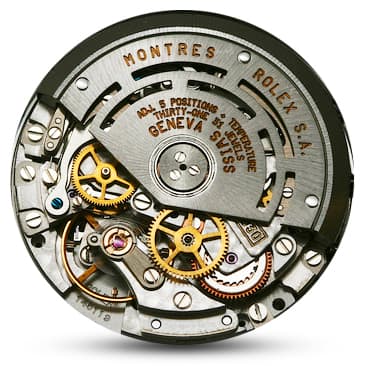Notes: This version of the 1990s Daytona family carries the baguette-diamond bezel set on an 18K gold case. This model was available with either a black, white or champagne dial color. It seems to only be available with a yellow gold case. There was no white gold option as far as we can tell.
Mechanism: Rolex decided not to simply shoehorn the Zenith El Primero into a Rolex case. Instead, they modified it. By the time they had finished, the El Primero had been through around 200 modifications and more than half of its original components had been swapped for those judged more suitable. It also had a new name; the Cal. 4030.
Of the myriad changes, the most significant was the drop in frequency. The Zenith movement arrived at Rolex’s door with a beat of 36,000vph and left at a more stately 28,800vph, matching the rest of the brand’s lineup. It’s the balance speed that gives the trademark sweep to the seconds hand, while also ensuring the caliber’s components receive less wear and tear and a longer time between services. (It was in direct contrast to the Valjoux movement, which Rolex had raised from 18,000vph to 21,600vph).
Of the myriad changes, the most significant was the drop in frequency. The Zenith movement arrived at Rolex’s door with a beat of 36,000vph and left at a more stately 28,800vph, matching the rest of the brand’s lineup. It’s the balance speed that gives the trademark sweep to the seconds hand, while also ensuring the caliber’s components receive less wear and tear and a longer time between services. (It was in direct contrast to the Valjoux movement, which Rolex had raised from 18,000vph to 21,600vph).
Family Notes: To many collectors, Rolex chronographs are grouped into two categories - Daytonas and "others". And while Rolex has been making chronographs since the 1930s , it wasn't until 1963 that the line of watches was categorized and named - and Daytona wasn't its first name. The original concept for this racing-inspired watch was The Rolex LeMans, and you can even find early advertising copy where the watch you see above - a true Mark I Daytona - is called LeMans. Needless to say, the name didn't stick, as Rolex's push into the American market and into official sponsorship of the 24 hour race at Daytona led to the naming of the reference 6239 Cosmograph as the Daytona. That didn't happen until 1964, and the watch in question here was produced in 1963, but we'll still call it a Daytona because it launched the reference, and thus the entire Daytona line.
From 1963 - 1988 Daytonas were Valjoux-sourced manual wind calibers; From 1988 - 2000 Rolex used a modified Zenith El Primero (Cal. 400). The Rolex version of this movement is called the caliber 4030. From 2000 to present the fully in-house, Rolex designed and manufactured automatic caliber 4130.
The bezel on this watch is distinctive. The numerals are all aligned so that they remain upright all the way around the dial, which is the old school look. A small design element common to all Daytona Cosmographs is sub dials that in some way contrast the dial.
From 1963 - 1988 Daytonas were Valjoux-sourced manual wind calibers; From 1988 - 2000 Rolex used a modified Zenith El Primero (Cal. 400). The Rolex version of this movement is called the caliber 4030. From 2000 to present the fully in-house, Rolex designed and manufactured automatic caliber 4130.
The bezel on this watch is distinctive. The numerals are all aligned so that they remain upright all the way around the dial, which is the old school look. A small design element common to all Daytona Cosmographs is sub dials that in some way contrast the dial.



